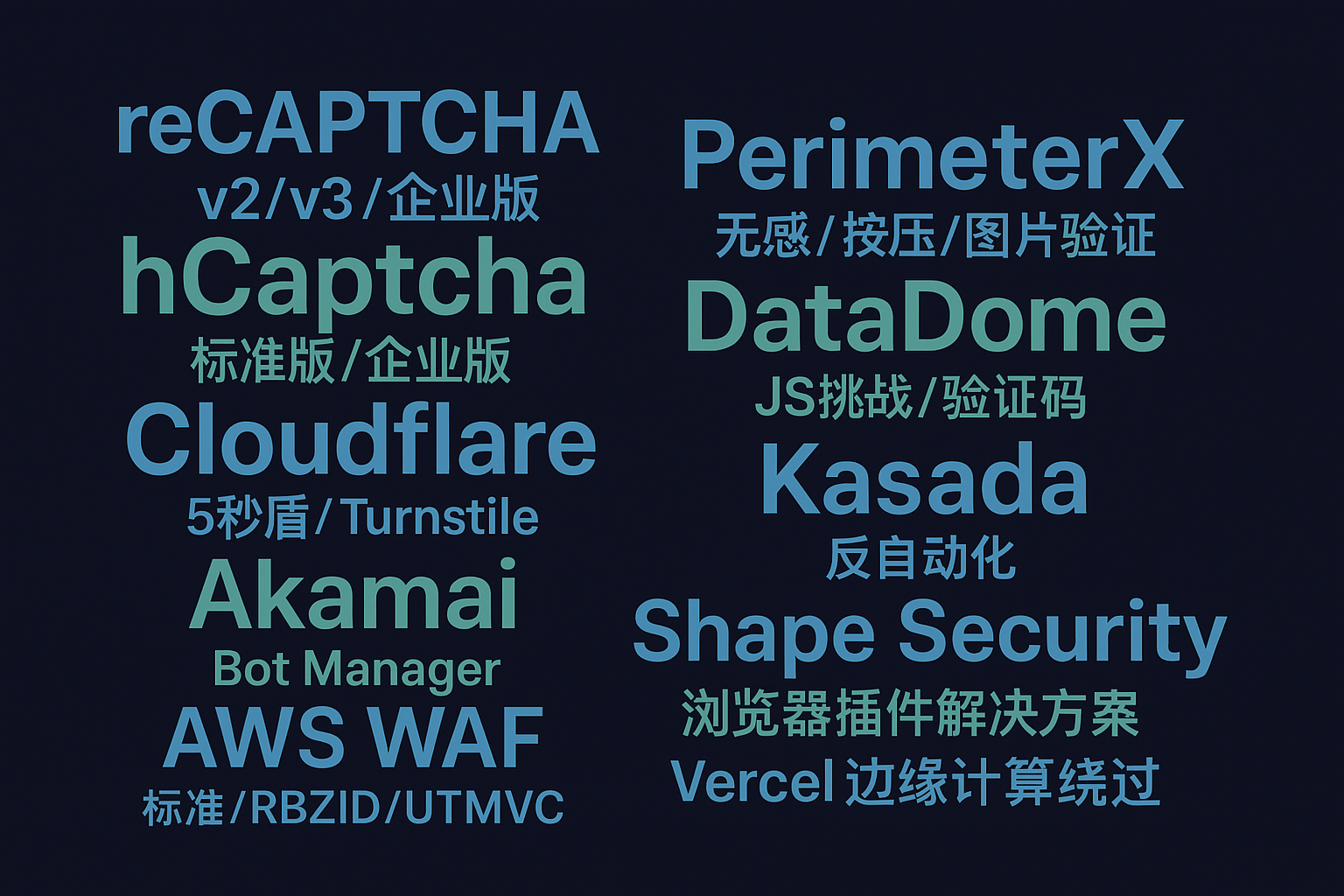hCaptcha验证码深度解析:图像识别算法与机器学习对抗技术研究
深入分析hCaptcha验证码的技术架构和图像识别机制,探讨其相较于reCAPTCHA的创新之处,并从计算机视觉角度研究验证码识别的机器学习算法实现和对抗策略。
hCaptcha验证码深度解析:图像识别算法与机器学习对抗技术研究
技术概述
hCaptcha作为验证码领域的新兴力量,在技术架构上采用了与reCAPTCHA截然不同的设计思路。它主要依托于图像分类任务,要求用户从多个选项中识别出符合特定要求的图片,如"选择包含自行车的图片"或"点击所有交通信号灯"。
相比于reCAPTCHA V3的隐形验证机制,hCaptcha采用了更加直观的人机交互方式。其核心优势在于数据收集的双重价值:在验证用户身份的同时,收集高质量的图像标注数据用于训练机器学习模型。这种"工作证明"(Proof of Work)机制不仅提供了安全防护,还为AI模型训练贡献了宝贵的数据资源。
从技术实现角度,hCaptcha的图像识别系统基于深度卷积神经网络(CNN),能够动态生成具有挑战性的图像识别任务。系统会根据当前的威胁级别和用户行为模式,智能调整验证难度,确保在保证安全性的同时不过度影响用户体验。
该系统的另一个技术亮点是其反自动化机制:通过分析用户的点击模式、鼠标轨迹、响应时间等多维度行为特征,识别潜在的自动化程序。这种多层次的验证策略使得传统的OCR技术和简单的图像识别算法难以有效突破。
核心原理与代码实现
图像识别机制分析
hCaptcha的图像识别系统包含以下核心组件:
- 图像预处理模块:对输入图像进行标准化、去噪、增强等操作
- 特征提取网络:使用CNN提取图像的高维特征表示
- 分类决策模块:基于特征向量进行多类别分类判断
- 对抗样本检测:识别和过滤经过特殊处理的攻击图像
以下是模拟hCaptcha图像识别系统的Python实现:
import numpy as np
import cv2
import torch
import torch.nn as nn
import torch.nn.functional as F
from torchvision import transforms, models
from PIL import Image
import base64
import io
import json
import hashlib
from typing import List, Dict, Tuple, Optional
from dataclasses import dataclass
import time
import random
@dataclass
class HCaptchaChallenge:
"""hCaptcha挑战数据结构"""
challenge_id: str
task_type: str # 'select_bicycle', 'select_traffic_light', etc.
images: List[str] # base64编码的图片数据
grid_size: Tuple[int, int] # 网格尺寸,如(3,3)
correct_indices: Optional[List[int]] = None
class HCaptchaImageProcessor:
"""hCaptcha图像处理器"""
def __init__(self, model_path: Optional[str] = None):
self.device = torch.device('cuda' if torch.cuda.is_available() else 'cpu')
self.transform = transforms.Compose([
transforms.Resize((224, 224)),
transforms.ToTensor(),
transforms.Normalize(mean=[0.485, 0.456, 0.406],
std=[0.229, 0.224, 0.225])
])
# 加载预训练的分类模型
self.model = self._load_classification_model()
# 定义常见的hCaptcha任务类型
self.task_classes = {
'bicycle': ['bicycle', 'bike', 'cycling'],
'traffic_light': ['traffic light', 'signal', 'stoplight'],
'car': ['car', 'vehicle', 'automobile'],
'bus': ['bus', 'coach', 'transit'],
'motorcycle': ['motorcycle', 'motorbike', 'scooter'],
'truck': ['truck', 'lorry', 'freight'],
'crosswalk': ['crosswalk', 'zebra crossing', 'pedestrian crossing']
}
def _load_classification_model(self) -> nn.Module:
"""加载图像分类模型"""
# 使用ResNet-50作为基础架构
model = models.resnet50(pretrained=True)
# 修改最后一层以适应hCaptcha的多任务分类
num_classes = len(self.task_classes) * 2 # 包含/不包含目标物体
model.fc = nn.Linear(model.fc.in_features, num_classes)
model = model.to(self.device)
model.eval()
return model
def preprocess_image(self, image_data: str) -> torch.Tensor:
"""预处理图像数据"""
# 解码base64图像
image_bytes = base64.b64decode(image_data)
image = Image.open(io.BytesIO(image_bytes)).convert('RGB')
# 应用预处理变换
tensor = self.transform(image).unsqueeze(0)
return tensor.to(self.device)
def detect_objects(self, image_tensor: torch.Tensor,
task_type: str) -> Dict[str, float]:
"""检测图像中的目标对象"""
with torch.no_grad():
# 前向传播
outputs = self.model(image_tensor)
probabilities = F.softmax(outputs, dim=1)
# 获取任务相关的分类结果
task_idx = list(self.task_classes.keys()).index(task_type)
positive_prob = probabilities[0][task_idx * 2].item()
negative_prob = probabilities[0][task_idx * 2 + 1].item()
return {
'contains_target': positive_prob,
'no_target': negative_prob,
'confidence': max(positive_prob, negative_prob),
'prediction': positive_prob > negative_prob
}
def analyze_image_features(self, image_tensor: torch.Tensor) -> Dict:
"""分析图像特征"""
# 提取CNN特征
with torch.no_grad():
# 获取ResNet的中间层特征
features = []
x = image_tensor
# 通过各个ResNet层
x = self.model.conv1(x)
x = self.model.bn1(x)
x = self.model.relu(x)
x = self.model.maxpool(x)
x = self.model.layer1(x)
features.append(x.mean(dim=[2, 3])) # 全局平均池化
x = self.model.layer2(x)
features.append(x.mean(dim=[2, 3]))
x = self.model.layer3(x)
features.append(x.mean(dim=[2, 3]))
x = self.model.layer4(x)
features.append(x.mean(dim=[2, 3]))
# 计算特征统计信息
feature_stats = []
for feat in features:
stats = {
'mean': feat.mean().item(),
'std': feat.std().item(),
'max': feat.max().item(),
'min': feat.min().item()
}
feature_stats.append(stats)
return {
'layer_features': feature_stats,
'feature_dimension': [f.shape[1] for f in features],
'total_parameters': sum(f.numel() for f in features)
}
class HCaptchaSolver:
"""hCaptcha求解器"""
def __init__(self):
self.processor = HCaptchaImageProcessor()
self.solve_history = []
def parse_challenge(self, challenge_data: Dict) -> HCaptchaChallenge:
"""解析hCaptcha挑战"""
challenge = HCaptchaChallenge(
challenge_id=challenge_data.get('challenge_id', self._generate_id()),
task_type=challenge_data.get('task_type', 'bicycle'),
images=challenge_data.get('images', []),
grid_size=tuple(challenge_data.get('grid_size', [3, 3]))
)
return challenge
def _generate_id(self) -> str:
"""生成挑战ID"""
return hashlib.md5(f"{time.time()}_{random.random()}".encode()).hexdigest()[:16]
def solve_challenge(self, challenge: HCaptchaChallenge,
threshold: float = 0.7) -> Dict:
"""解决hCaptcha挑战"""
start_time = time.time()
results = []
correct_indices = []
print(f"开始解决hCaptcha挑战: {challenge.task_type}")
print(f"图像数量: {len(challenge.images)}")
print(f"网格尺寸: {challenge.grid_size}")
# 处理每个图像
for idx, image_data in enumerate(challenge.images):
try:
# 预处理图像
image_tensor = self.processor.preprocess_image(image_data)
# 检测目标对象
detection_result = self.processor.detect_objects(
image_tensor, challenge.task_type
)
# 分析图像特征
feature_analysis = self.processor.analyze_image_features(image_tensor)
# 判断是否包含目标
contains_target = detection_result['contains_target'] > threshold
if contains_target:
correct_indices.append(idx)
result = {
'index': idx,
'contains_target': contains_target,
'confidence': detection_result['confidence'],
'probabilities': detection_result,
'features': feature_analysis
}
results.append(result)
print(f"图像 {idx}: {'✓' if contains_target else '✗'} "
f"(置信度: {detection_result['confidence']:.3f})")
except Exception as e:
print(f"处理图像 {idx} 时出错: {e}")
results.append({
'index': idx,
'contains_target': False,
'confidence': 0.0,
'error': str(e)
})
# 模拟人类点击时间
human_delay = random.uniform(2.0, 5.0)
time.sleep(human_delay)
solve_time = time.time() - start_time
solution = {
'challenge_id': challenge.challenge_id,
'task_type': challenge.task_type,
'correct_indices': correct_indices,
'total_images': len(challenge.images),
'selected_count': len(correct_indices),
'solve_time': solve_time,
'success_rate': len([r for r in results if 'error' not in r]) / len(results),
'detailed_results': results
}
self.solve_history.append(solution)
print(f"\n求解完成! 选择了 {len(correct_indices)} 个图像")
print(f"总用时: {solve_time:.2f} 秒")
print(f"选择的图像索引: {correct_indices}")
return solution
def simulate_human_behavior(self, challenge: HCaptchaChallenge) -> Dict:
"""模拟人类行为模式"""
behavior_data = {
'mouse_movements': [],
'click_timings': [],
'hesitation_patterns': []
}
# 模拟鼠标移动轨迹
grid_width, grid_height = challenge.grid_size
cell_width, cell_height = 100, 100 # 假设每个网格单元100x100像素
for i in range(len(challenge.images)):
row = i // grid_width
col = i % grid_width
# 计算网格中心点
center_x = col * cell_width + cell_width // 2
center_y = row * cell_height + cell_height // 2
# 添加人类特有的随机偏移
actual_x = center_x + random.gauss(0, 10)
actual_y = center_y + random.gauss(0, 10)
# 模拟观察时间(人类需要时间识别图像)
observation_time = random.uniform(0.8, 2.5)
behavior_data['mouse_movements'].append({
'x': actual_x,
'y': actual_y,
'timestamp': time.time() + observation_time,
'hover_duration': observation_time
})
# 模拟犹豫模式(人类在不确定时会犹豫)
if random.random() < 0.3: # 30%的概率出现犹豫
hesitation_duration = random.uniform(0.5, 1.5)
behavior_data['hesitation_patterns'].append({
'image_index': i,
'hesitation_time': hesitation_duration,
'reason': 'uncertainty'
})
return behavior_data
# 高级图像分析工具
class HCaptchaAdvancedAnalyzer:
"""hCaptcha高级分析工具"""
def __init__(self):
self.solver = HCaptchaSolver()
def analyze_challenge_difficulty(self, challenge: HCaptchaChallenge) -> Dict:
"""分析挑战难度"""
difficulty_metrics = {
'image_quality': [],
'object_clarity': [],
'background_complexity': [],
'overall_difficulty': 0.0
}
for image_data in challenge.images:
try:
# 解码图像
image_bytes = base64.b64decode(image_data)
image = cv2.imdecode(np.frombuffer(image_bytes, np.uint8), cv2.IMREAD_COLOR)
# 计算图像质量指标
gray = cv2.cvtColor(image, cv2.COLOR_BGR2GRAY)
# 清晰度评估(拉普拉斯方差)
clarity = cv2.Laplacian(gray, cv2.CV_64F).var()
# 背景复杂度(边缘密度)
edges = cv2.Canny(gray, 50, 150)
complexity = np.sum(edges > 0) / edges.size
# 图像质量(基于直方图分析)
hist = cv2.calcHist([gray], [0], None, [256], [0, 256])
quality = np.std(hist) # 直方图标准差作为质量指标
difficulty_metrics['image_quality'].append(quality)
difficulty_metrics['object_clarity'].append(clarity)
difficulty_metrics['background_complexity'].append(complexity)
except Exception as e:
print(f"分析图像时出错: {e}")
# 计算总体难度
if difficulty_metrics['image_quality']:
avg_quality = np.mean(difficulty_metrics['image_quality'])
avg_clarity = np.mean(difficulty_metrics['object_clarity'])
avg_complexity = np.mean(difficulty_metrics['background_complexity'])
# 标准化并计算综合难度分数
difficulty_metrics['overall_difficulty'] = (
(1.0 - min(avg_clarity / 1000, 1.0)) * 0.4 + # 清晰度越低难度越高
avg_complexity * 0.4 + # 背景越复杂难度越高
(1.0 - min(avg_quality / 10000, 1.0)) * 0.2 # 质量越低难度越高
)
return difficulty_metrics
def benchmark_solver_performance(self, test_challenges: List[Dict]) -> Dict:
"""性能基准测试"""
results = {
'total_challenges': len(test_challenges),
'successful_solves': 0,
'average_solve_time': 0.0,
'accuracy_by_task': {},
'detailed_results': []
}
total_time = 0.0
task_accuracy = {}
for challenge_data in test_challenges:
challenge = self.solver.parse_challenge(challenge_data)
solution = self.solver.solve_challenge(challenge)
# 检查求解是否成功
if solution['success_rate'] > 0.8: # 80%以上成功率认为成功
results['successful_solves'] += 1
total_time += solution['solve_time']
# 按任务类型统计准确率
task_type = challenge.task_type
if task_type not in task_accuracy:
task_accuracy[task_type] = []
task_accuracy[task_type].append(solution['success_rate'])
results['detailed_results'].append(solution)
# 计算平均值
if results['total_challenges'] > 0:
results['average_solve_time'] = total_time / results['total_challenges']
# 计算各任务类型的平均准确率
for task_type, accuracies in task_accuracy.items():
results['accuracy_by_task'][task_type] = np.mean(accuracies)
return results
# 使用示例
def demonstrate_hcaptcha_analysis():
"""演示hCaptcha分析过程"""
# 创建模拟的hCaptcha挑战
sample_challenge = {
'challenge_id': 'demo_challenge_001',
'task_type': 'bicycle',
'grid_size': [3, 3],
'images': []
}
# 注意:实际使用时需要真实的base64图像数据
# 这里使用占位符
for i in range(9):
sample_challenge['images'].append('placeholder_base64_data')
analyzer = HCaptchaAdvancedAnalyzer()
challenge = analyzer.solver.parse_challenge(sample_challenge)
print(f"hCaptcha挑战分析演示")
print(f"任务类型: {challenge.task_type}")
print(f"网格尺寸: {challenge.grid_size}")
print(f"图像数量: {len(challenge.images)}")
# 分析挑战难度
# difficulty = analyzer.analyze_challenge_difficulty(challenge)
# print(f"挑战难度评分: {difficulty['overall_difficulty']:.3f}")
# 模拟人类行为
behavior = analyzer.solver.simulate_human_behavior(challenge)
print(f"鼠标移动事件数量: {len(behavior['mouse_movements'])}")
print(f"犹豫模式检测到: {len(behavior['hesitation_patterns'])} 次")
return challenge
if __name__ == "__main__":
challenge = demonstrate_hcaptcha_analysis()
print("\nhCaptcha分析系统已准备就绪")
机器学习对抗策略研究
从安全研究角度,理解hCaptcha的识别机制对于提升验证码系统的安全性具有重要意义。AI驱动验证码识别 - 支持18种主流验证码类型在这方面提供了深入的技术支持和研究工具。
现代的验证码破解技术主要依赖于深度学习模型,特别是卷积神经网络(CNN)在图像识别任务中的优异表现。然而,hCaptcha通过以下策略增强了抗攻击能力:
- 动态任务生成:根据当前威胁情况动态调整识别任务的类型和难度
- 图像质量变化:通过添加噪声、模糊、旋转等变换增加识别难度
- 时序行为分析:监控用户的点击时间模式,识别机器化的快速响应
- 上下文关联:结合多个图像的语义关系进行综合判断
对于企业级安全防护,建议采用类似的多维度验证策略。同时,应该建立持续学习机制,根据攻击模式的变化不断优化验证算法。专业reCAPTCHA解决方案 - 企业级验证码服务为此提供了完整的技术解决方案。
技术发展前景
hCaptcha代表了验证码技术向实用性和价值创造的重要转变。通过将人机验证与有价值的数据标注任务结合,它不仅提供了安全防护,还为人工智能模型的训练贡献了高质量数据。
未来的验证码技术将更加注重用户体验和数据价值的平衡。我们可以预见,基于生成对抗网络(GAN)的动态验证码、基于生物特征的无感验证、以及基于区块链的去中心化验证等技术将逐渐成熟。
对于安全研究人员而言,深入理解这些新兴技术的原理和实现方式至关重要。只有通过持续的技术研究和实践,才能在不断演进的网络安全威胁面前保持技术优势,构建更加安全可靠的网络环境。

关键词标签: hCaptcha, 验证码识别, 图像分类, 深度学习, CNN, 计算机视觉, 机器学习对抗, 人机验证技术, 图像处理算法
更多推荐
 已为社区贡献7条内容
已为社区贡献7条内容









所有评论(0)